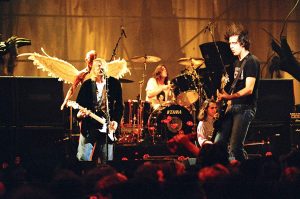When a band covers a song, it is commonplace to add their own unique twist to the sound of the original. Take Hendrix’s obtrusive, amplified interpretation of Dylan’s folk-rock single “All Along the Watchtower.” Hendrix replaces the acoustic guitar and harmonica with a twelve-string and incendiary guitar solos. Besides the words and overall melody, the two versions are nothing more than distant cousins.
And then there’s Weezer, who just released their surprise Teal Album last Thursday to build anticipation for their upcoming Black Album set to release on March 1. Unlike the Black Album, however, the Teal Album is comprised exclusively of covers spanning 38 years and a diverse set of genres. While fans of the 17-year-old band may have hoped for a power-pop approach towards unifying this wide range of songs, the band does the complete opposite. When listened to in one sitting, the album sounds like a mixtape put together by a college radio DJ trying to capture each quintessential moment in music from the ‘60s to the ‘90s—this is further supported by the fact that Weezer bookends the time gap with songs that both peaked at number one on the US Billboard Hot R&B Songs (Ben E. King’s 1961 “Stand By Me” and TLC’s 1999 “No Scrubs”). You really have to keep reminding yourself that you’re listening to a Weezer album and not a greatest hits compilation.
There are two distinct types of covers. There are “reinterpretations,” which is what Hendrix did by adding his own trademark style to the acoustic original; then there are “reproductions,” which is what Weezer does on the Teal Album for a majority of the tracks. The former is usually held in higher regard as the process of reinterpretation adds creativity to a song that either lacks stylistically or whose period of success has already passed. The reason Hendrix’s “All Along the Watchtower” gained such a following is because it fed a hungry audience of hard-rockers and psychedelics that may not have been interested in Dylan’s no-frills original. If Hendrix traded in his stratocaster for a harmonica, it’s unlikely the song would be more associated with the Seattle acid-rocker than the Minnesota folk-singer because, in reality, why would you listen to a replication when you could listen to the original?
Despite Weezer taking a reproduction approach to many of the songs on this album, it should not deter listeners. Yes, during certain songs on the album the band sounds almost identical to the original recordings, but there is something to be said for their level of parity. In their cover of ELO’s 1978 masterpiece, “Mr. Blue Sky,” Weezer tasks itself with recreating what exactly makes Electric Light Orchestra an orchestra. In the original, ELO’s Jeff Lynne employs an army of musicians playing a diverse selection of instruments that might seem dissonant at first glance. These range from the violins and cellos, which prevail during the instrumental sections, to the electric guitar talk box used in the bridge. Instead of stripping the song down to a guitar-bass-drum rock formation, Weezer bandleader Rivers Cuomo took on the risk of mimicking the art-rock piece faithfully. Their drive to imitate is further represented by their electrifying cover of Black Sabbath’s 1970 rock anthem “Paranoid.” On this track, Cuomo passes the microphone to guitarist Brian Bell who delivers an absolutely impeccable impersonation of Ozzy.
If Weezer simply released one of these reproductions alone, I might not give the band the same praise. In that case, I would refer to the aforementioned “original-better-than-the-replication” argument. But Weezer does something spectacular with this project that cannot be ignored: they successfully replicate songs from drastically different eras, putting them together into a melting pot of sound. (https://www.peakfighting.com) A cover album like Ryan Adams 2015 re-creation of Taylor Swift’s 1989 gathers interest because he took one artist’s work and transformed it completely into his own. However, Weezer didn’t just cover a slew of Beatles songs. They methodically hand-picked songs that spoke to people at their time of relevance and created a sort of anthologized timeline of pop culture. Their level of imitation is not as important as their desire to accurately create a montage of the second half of the 21st century.
By taking on such a grueling job, Weezer has reassured the public that they are still relevant and here to stay. They have popped out album after album for the past 25 years and show no signs of slowing down—the Black Album will mark their fourth studio album in less than three years. While Weezer purists (queue Leslie Jones in Saturday Night Live’s Weezer sketch) will claim the band started to decline as they gradually shifted away from their 90s alt-rock sound, it can’t be denied that Cuomo knows what music fans want and does a great job at adhering to their needs.
In the mid-90s, they filled the hole left by Kurt Cobain’s sudden death. In 2019, they continue to supply teens and adults with the music they need. To do this, though, they needed to make a few stylistic changes, evident in the more pop-oriented sound on the White Album (2016) and Pacific Daydream (2017). Yes, they’ve changed—but it’s working. There’s a reason today’s teenagers know who Weezer is and not Eve 6 or Candlebox. They continue to adapt and deserve credit where credit’s due. Their surprise cover album is just the latest tool Cuomo has used to remain in the public eye two and half decades later.





